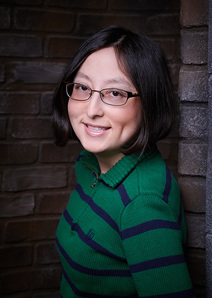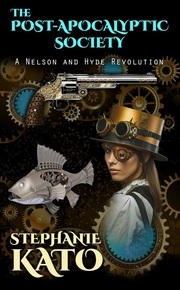SELF-PUBLISHING SUCCESS STORY:
STEPHANIE KATO
Hi Stephanie, and thanks for sharing with us.
You're welcome.
Most people may be unfamiliar with the steampunk genre. Can you explain what Steam-punk is?
It’s a subgenre of science fiction that is traditionally set in an alternate version of the Victorian era or 19th century in general. Steampunk settings are much more advanced in technology than the historical 19th century. Readers frequently see industrialization, genetic engineering, political corruption, Victorianism, Romanticism, monsters, false utopias, time travel, and other fantasy elements. Some steampunk books take place in contemporary or futuristic settings too. These settings are often retro futures that reverted back to Victorian aesthetics and steam power. Sometimes, a post-apocalyptic event or cultural upheavals cause these retro futures. Steampunk is actually a derivative of another subgenre called cyberpunk. The “punk” element in steampunk is usually a cultural or political rebellion. Steampunk protagonists are often Romantic heroes who use their suffering and ideals to overcome obstacles.
How long has this book been germinating in you?
Four or five years. Originally, I wrote murder mysteries, but the results disappointed me. So, I chose to use the same characters and themes in a different setting. I thought it might be interesting to reboot my series in a post-apocalyptic future. Then I needed to add more thematic material to make my books unique. I spent a long time researching various types of science fiction, ranging from cyberpunk, superheroes, space epics, and whatnot. Finally, I believed steampunk was the perfect setting because it gave my post-apocalyptic environment a chance to have a great Industrial Revolution for a better future.
After you committed to writing it, about how long did it take to get it completed?
Not that long. I drafted the first three books in a year. The self-publishing process took around three months. Most of that time was spent on the editing and revisions.
What are the primary themes in your book?
In a way, my book is a twisted morality tale. Loyalty to allies is an essential theme in my book. Everyone needs help sometimes, so we should have each other’s backs. My book also reminds us that our lives could be much worse. In their darkest hours, my characters maintain the hope and courage to persevere. Disasters usually bring out the best or worst in people and you’ll also see that from my characters. Evolution is another interesting concept in my book and a common steampunk theme. Those who cannot evolve will be left behind in the dust. I’m sure readers will find other themes in my book, but those are some examples.
Do you have any predictions for the future of steampunk?
I’m definitely seeing some trends that could lead to an interesting future. Steampunk is infiltrating mainstream entertainment and many people don’t even know it. Mad Max: Fury Road was a post-apocalyptic film that definitely had some steampunk influences. Fallout 4, the Borderlands series, and BioShock series are popular video games that also have some steampunk elements. Even the technology and costumes in superhero films are adapting some steampunk components. During the past few years, several steampunk works were set in post-apocalyptic or dystopian environments. This phenomenon is probably a reaction to current events, but that’s just my opinion. Remember how I said steampunk piggy backed on cyberpunk? Now it seems like other budding subgenres of science fiction are doing the same thing to steampunk. But that can be a discussion for another time. I’ll keep on eye several trends and post the results on my blog.
It sounds like you really know your genre. Do you have any suggestions for budding steampunk writers?
Research and a huge imagination are very important. I think most creative writing can benefit from research, but it’s absolutely necessary for steampunk. At the very least, I recommend some general research on the Victorian era, 19th century Romanticism, and western Industrial Revolutions. A writer will find many changes in technology, gender roles, fashion, socioeconomics, work forces, and more from 19th century history. Steampunk also requires a lot of world building and that’s why it’s important to have a vivid imagination. Include huge cities, elaborate clothing, technology that defies logic, and find creative ways to use steam power. A steampunk writer can create entire subcultures and species of creatures. Steampunk might sound like a demanding genre, but meek and understated won’t make the cut.
And now, more about the publishing process itself. Were you intimidated at all about going the self-publishing route?
Yes. I didn’t know where to start. There are many vanity presses and self-publishing options, but I couldn’t tell who appeared authentic and professional. Most of the self-publishing packages were several thousand dollars. It seemed ridiculously expensive. However, self-publishing was probably my only option. The majority of authors who submit their work to traditional publishers usually receive rejection letters or hear nothing at all. Like everything else, I believe writers need connections to succeed with traditional publishing.
How did Christopher J. Lynch’s self-publishing seminar help you?
It was a huge blessing. I didn’t have very much direction before attending his self-publishing seminar. From that moment on, I found a great book cover designer, editor, formatter, web designer, and more. Chris also gave awesome tips for marketing and using online communities. One of the things I learned is the value of networking and self-promotion. People aren’t going to buy and read my book if they don’t know it exists. It’s also important for young writers like me to connect with experienced authors. Being around reputable authors is a good way to strengthen my own writing and build connections.
How do you feel now that you have a book published?
Fantastic! This is a very exciting time for me. I released my first book and it’s definitely a life changing experience. It gave me a great sense of accomplishment and I believe many readers will enjoy my book. However, it’s a double edged sword. Writing and self-promotion takes a lot of time, patience, and energy. It’s challenging to balance my day job, social time, rest and relaxation, writing, research, and marketing.
What’s next for you?
There are a few things on my plate. I’m going to start revising my second book in the near future. It’s a continuation of my book series with the same main characters. In the fall, I’m going to attend my first Comic Con. That might sound silly, but it will be a good place for me to meet and network with other science fiction enthusiasts. I also want to find someone who can either make or order a couple steampunk outfits for me. Many steampunk fans attend conventions and engage in cosplay. So, it makes sense for me to become part of the steampunk community.
Well thank you so much for stopping by Stephanie.
You're very welcome Chris.
To purchase a copy of The Post-Apocalyptic Society click on the image above or here.
You can contact Stephanie on her website:
http://www.stephaniekatoauthor.com
or on Twitter: https://www.twitter.com/stephkato
or follow her on Facebook: https://www.facebook.com/stephanie.kato.12


 RSS Feed
RSS Feed
